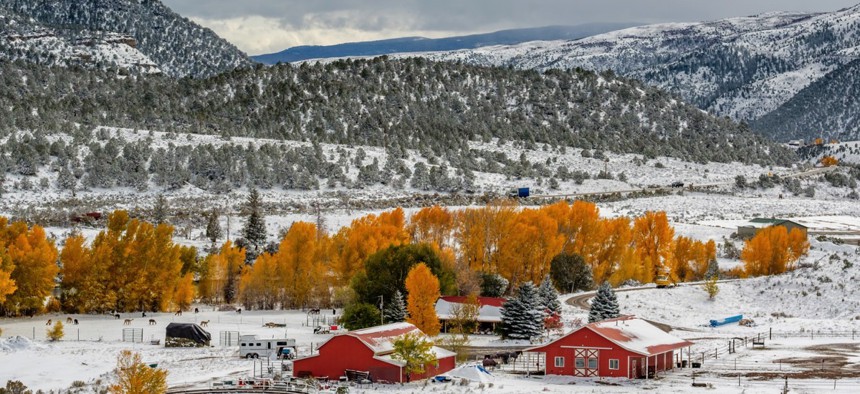FCC Dinged Over Lack of Federal Strategy for Rural Broadband Adoption


Connecting state and local government leaders
“They have the authority, but I don’t know if they have the political interest,” said the National Digital Inclusion Alliance's director during Senate Commerce subcommittee questioning.
WASHINGTON — The Internet of Things can’t permeate rural America without a unified federal strategy for broadband infrastructure and adoption, according to panelists at a U.S. Senate Commerce subcommittee hearing on Tuesday.
That a strategy is wanting is evidenced by the lack of accurate broadband adoption data at the Federal Communications Commission, which has taken to crowdsourcing information because of the poor quality of census block maps.
Accurate data breeds accurate maps important at both the federal and local levels.
“There’s a handful of programs for infrastructure—federal programs,” Angela Siefer, the National Digital Inclusion Alliance's director, said during the Advancing the Internet of Things in Rural America hearing. “I can tell you there are no functioning broadband adoption federal programs right now.”
That’s proving problematic for farmers and ranchers, who face challenging weather conditions and fluctuating commodity markets.
Agriculture equipment manufacturer Lindsay Corporation offers an IoT solution that relies on remote data collection and analysis from soil moisture sensors, as well as weather and crop genetics recommendations, to determine the center pivots of irrigation systems. In layman’s terms, irrigation occurs precisely when crops need it at the exact amount—improving yields while decreasing water use by 17 percent.
That’s an average of $40-per-acre savings farmers can reinvest in their operations and local economies, said Timothy Hassinger, Lindsay Corporation's president and CEO.
“For farmers across the country these technologies are no longer luxuries. Rather they’re critical tools needed to increase the overall operational efficiency and productivity needed to compete in the global marketplace,” Hassinger said. “However, farmers can only employ these connected tools if they have reliable, high-speed internet access, and for an estimated 39 percent of the rural population, it’s simply not available.”
“While cities and municipalities typically have access to several high-speed internet service providers, that access often ends at the county line,” he added.
Farmers are left with the limited connectivity of radio, satellite and cell networks, and the digital divide is widening.
Oil and gas fleet management service Cartasite found more than 10 percent of its workers’ time is spent outside cell coverage areas.
“This is an enormous amount of our country that is currently not covered by spectrum, by any cellular coverage at all,” said David Armitage, Cartasite founder and CEO. “We don’t see it when we drive down the nation’s highways. We absolutely see it when we drive in these rural areas of the U.S.”
On track to exceed the 1970 high of 10 billion barrels of crude a day, the oil and gas industry remains a “relatively high-cost producer,” he added, and IoT is streamlining business processes, enhancing worker safety and reducing environmental impacts to reduce costs.
Real-time remote monitoring, predictive analytics, cloud computing and smart sensors are increasingly employed at a time when tens of thousands of workers are losing their jobs and rural communities are slashing their budgets.
“IoT presents a transformative solution for enterprise operations of all types and sizes all over the United States,” said Michael Terzich, Zebra Technologies chief administrative officer. “The benefits of B2B IoT solutions are allowing companies to work smarter, enhance productivity, create jobs and improve the overall economy.”
But users of Zebra’s marking, tracking and computer printing products “need unfettered access to high-quality, high-speed” wired and wireless internet, he said, adding the health care value chain remains one of the least efficient.
Wired broadband in the home is thought to be the best delivery method for remote patient monitoring of chronic disease, said Michael Adcock, Telehealth Center University of Mississippi Medical Center executive director. Through a partnership the center was able to secure the next-best option, mobile broadband, for an early diabetic eye disease recognition pilot that determined if 20 percent of diabetics in its program used remote patient monitoring the savings would reach $180 million.
Adcock, who said disease burden is greatest in rural America, backed the SPEED Act U.S. Sen. Roger Wicker, R-Miss., and Sen. Catherine Cortez Masto, D-Nev., introduced last month to streamline permitting around broadband infrastructure deployment. Wicker also expressed interest in using the FCC’s Universal Service Fund “to adequately expand broadband in rural communities.”
“The benefits of telehealth are not available to patients without access to high-speed internet,” Adcock said. “As technology and health care services expand to meet patients where they live, broadband coverage must improve to make this care accessible.”
In a year when 8.4 million IoT devices are in use, the FCC keeps no data on the costs of having broadband in the home by area. Providers list introductory prices on their websites, but those are ballpark figures.
Legislation is needed to have the FCC map the most expensive and least expensive broadband costs, Siefer told Wicker.
“They have the authority,” she said of the FCC. “But I don’t know if they have the political interest.”
Dave Nyczepir is a News Editor at Government Executive’s Route Fifty and is based in Washington, D.C.

NEXT STORY: Satellite data gives responders baseline for recovery efforts





